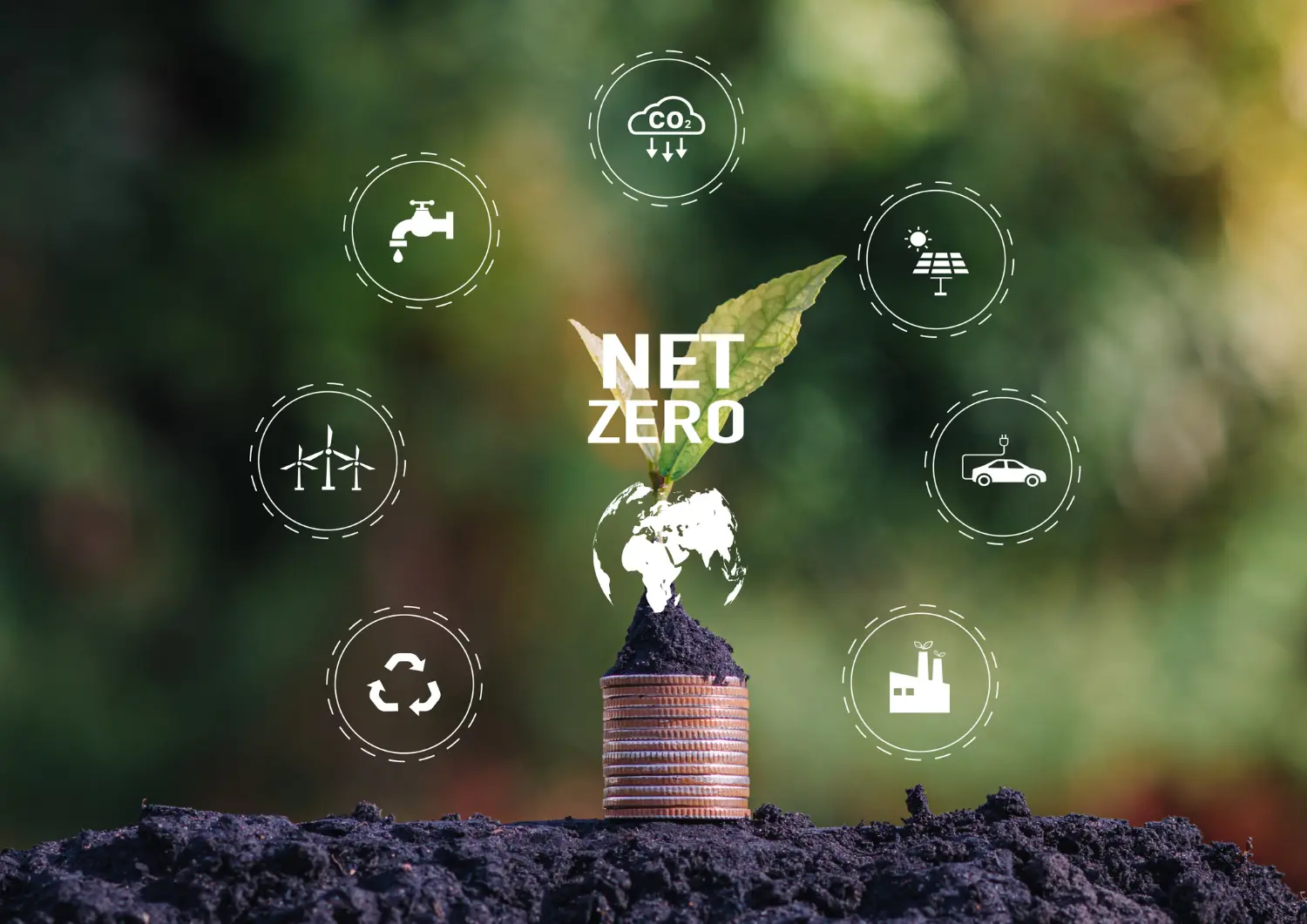Net zero is often seen as a distant utopia, but today it is an essential roadmap. This concept, which combines emissions reduction and carbon offsets, is redefining organizations’ climate strategies.
Net Zero : Definitions
The IPCC provides the following net-zero definition: zero net emissions is the level at which global anthropogenic greenhouse gas emissions (generated by human activities) will be balanced by anthropogenic removals (IPCC, SR15).
In other words, it’s a strategy aimed at not increasing the amount of greenhouse gases in the atmosphere. This approach is crucial to countering temperature increase and meeting global climate plans and targets.
Net zero 2030: This ambitious objective aims to achieve carbon neutrality by 2030, by drastically reducing emissions at source while accelerating offset projects. It often concerns leading companies or organizations that want to act quickly to limit global warming in the short term.
Net zero 2050: This scenario is aligned with global commitments to keep global warming below 1.5°C, as set out in the Paris Agreement. It involves a gradual transition, enabling the highest-emitting sectors to reduce their emissions at a realistic pace while adopting long-term technological solutions.
What’s the difference between net zero emissions, carbon neutrality and traditional emissions reductions?
Unlike traditional methods focusing exclusively on reducing direct and indirect emissions, net zero emissions goals represents a global strategy. This includes not only reducing emissions, but also offsetting residual emissions through recognized and effective practices such as the voluntary carbon market.
What’s the difference between carbon neutrality and net zero?
Apart from the net zero definition, other related concepts are worth mentioning. Net-zero-emissions still differs from carbon-neutral (climate neutral) targets in being more precise about carbon-offset criteria, as presented in the table below:
Carbon Neutrality or Net Zero ?
| Carbon Neutrality | Net Zero | |
| Definition | Term coined under the Kyoto Protocol in the late 1990s. A company achieves carbon neutrality when its greenhouse gas (GHG) emissions are fully offset (in equivalent tons) by carbon credits. (The definition of carbon neutrality does not therefore imply any notion of upstream decarbonization through reduction projects). | According to the IPCC, the net zero definition is reached when global emissions of greenhouse gases caused by human activities are fully offset by absorptions of the same gases, also due to human actions. |
| Scope of application | Organizations are free to choose the scope of emissions included in their carbon footprint. | According to the SBTi standard, all direct and indirect emissions must be included, across the entire value chain. Must include scope 1, 2 (95%) and 3 (67%) |
| Emissions reduction requirements (emissions targets) | No regulations or requirements are associated with reductions. | Ambitious emissions reductions aligned with climate science, consistent with the IPCC’s 1.5°C trajectory. |
| Climate contribution | Carbon offsetting can take the form of avoidance, reduction or sequestration projects. | Up to net zero, offsetting can be achieved through carbon avoidance, reduction or sequestration projects. Thereafter, the neutralization of residual emissions (after reduction) is achieved solely through sequestration projects, to remove carbon from the atmosphere. |
| Examples | A company can declare itself on scope 1 and 2, and ignore scope 3, then declare itself carbon-neutral on the said scope. | A company follows SBTi, standards and climate science to declare net zero on scopes 1 and 2. This will take more time and effort to implement, but the company will gain the trust of its stakeholders. |
| Related certifications | Only the norm PAS 2060 is the benchmark for certifying carbon neutrality | Join the SBTi movement to be listed on their website as an organization committed to Net Zero 2030 or 2050 |
| Types of participating organizations | Small, medium-sized and large companies, NPOs and public authorities. More participation because less demanding and more realistically achievable for organizations with ESG departments and limited resources and budgets. | Primarily aimed at large companies with substantial resources and budgets. Because of their size and leadership positions, public opinion is more demanding of these companies and organizations, which therefore redouble their efforts to meet the expectations of the market and all stakeholders in society in achieving global net zero objectives. |
Definition
Carbon Neutrality: Term coined under the Kyoto Protocol in the late 1990s. A company achieves carbon neutrality when its greenhouse gas (GHG) emissions are fully offset (in equivalent tons) by carbon credits. (The definition of carbon neutrality does not therefore imply any notion of upstream decarbonization through reduction projects).
Net Zero: According to the IPCC, the net zero definition is reached when global emissions of greenhouse gases caused by human activities are fully offset by absorptions of the same gases, also due to human actions.
Scope of application
Carbon Neutrality: Organizations are free to choose the scope of emissions included in their carbon footprint.
Net Zero: According to the SBTi standard, all direct and indirect emissions must be included, across the entire value chain. Must include scope 1, 2 (95%) and 3 (67%).
Emissions reduction requirements (emissions targets)
Carbon Neutrality: No regulations or requirements are associated with reductions.
Net Zero : Ambitious emissions reductions aligned with climate science, consistent with the IPCC’s 1.5°C trajectory.
Climate contribution
Carbon Neutrality: Carbon offsetting can take the form of avoidance, reduction or sequestration projects.
Net Zero : Up to net zero, offsetting can be achieved through carbon avoidance, reduction or sequestration projects. Thereafter, the neutralization of residual emissions (after reduction) is achieved solely through sequestration projects, to remove carbon from the atmosphere.
Examples
Carbon Neutrality: A company can declare itself on scope 1 and 2, and ignore scope 3, then declare itself carbon-neutral on the said scope.
Net Zero: A company follows SBTi, standards and climate science to declare net zero on scopes 1 and 2. This will take more time and effort to implement, but the company will gain the trust of its stakeholders.
Related certifications
Carbon Neutrality: Only the norm PAS 2060 is the benchmark for certifying carbon neutrality.
Net Zero: Join the SBTi movement to be listed on their website as an organization committed to Net Zero 2030 or 2050
Types of participating organizations
Carbon Neutrality: Small, medium-sized and large companies, NPOs and public authorities. More participation because less demanding and more realistically achievable for organizations with ESG departments and limited resources and budgets.
Net Zero: Primarily aimed at large companies with substantial resources and budgets. Because of their size and leadership positions, public opinion is more demanding of these companies and organizations, which therefore redouble their efforts to meet the expectations of the market and all stakeholders in society in achieving global net zero objectives.
Do you have net zero emissions or carbon neutral targets? Contact our carbon portfolio managers, who can advise you on our premium carbon credits and the climate contribution plan best suited to your objectives! Also, get peace of mind to produce your next ESG annual report.
Why should companies aim for net zero?
Achieving net zero is not just a climate imperative, it’s also a strategic opportunity for businesses. Here are some key benefits:
Meeting the growing expectations of stakeholders
- 71% of consumers want to buy from brands that are committed to the environment (source: Capgemini).
- 85% of institutional investors consider ESG issues, including climate, to be decisive in their investment decisions (source: PwC).
Accessing new markets and financing
- Companies aligned with attractive climate targets attract green financing more easily. In 2023, green bonds exceeded $1,000 billion in issuance.
Public and private markets are increasingly incorporating sustainability-related criteria into their tenders.

Net zero: an opportunity for the green economy and a fairer society

Why is it essential to achieve net zero emissions?
Achieving net zero emissions is fundamental to stabilizing global temperatures and minimizing climate risks. This goal encourages companies, particularly large international corporations and brands (e.g. Ferrari, Ubisoft etc…), to review their activities and invest in environmentally-friendly practices to become true leaders of change. In this way, a snowball effect positively impacts the entire value chain of these major brands, such as the ecosystem of SMEs that often gravitates around them (suppliers, service providers, partners, investors…).
This includes optimizing financial resources towards projects that support the green economy and innovation in emissions reduction. At the same time, it fosters stakeholder engagement in the implementation of small- and large-scale strategies that are essential for a sustainable future.
Impact of emissions on climate change and the environment
Anthropogenic carbon footprint, particularly the combustion of fossil fuels, is the main driver of global warming. This warming intensifies extreme weather phenomena and threatens biodiversity.
Adopting a net zero emissions approach helps reverse these alarming trends by promoting a transition to renewable energy sources, reduced energy demand, sustainable resource management and low-carbon value and supply chains. Possible relays for carbon sequestration finally fill the remaining incompressible residual emissions.
Consequences of emissions on health and society
Beyond their environmental impact, carbon emissions have direct repercussions on public health. They exacerbate air quality problems, increasing the risk of respiratory and cardiovascular disease. Socially, they accentuate inequalities, with the poorest communities often the most vulnerable to climate risks.
Climate disasters, which are more frequent and intense due to anthropogenic GHG emissions, hit poor populations harder, as explained in the American Scientific article. Moving towards net zero emissions therefore represents a crucial step not only in protecting our planet, but also in building a more equitable, resilient and economically prosperous society.
Transforming the energy sector for a sustainable future
The transition to a sustainable energy future is at the heart of the fight against climate change. Renewable energies, such as wind, solar and hydroelectric power, play a crucial role in this transformation, offering clean alternatives to fossil fuels.
The role of renewable energies in reducing emissions
Key measures, a successful framework and ambitious goals are the cornerstones of a desirable future for companies, governments and society.

Widespread adoption of renewable energies is essential to achieving net-zero targets. These technologies provide clean, inexhaustible energy, reducing dependence on fossil fuels and, consequently, greenhouse gas emissions. The carbon intensity of renewable energies is also lower than that of fossil fuels. This means that for every 1 kWh (kilowatt-hour) of energy produced, renewable solutions emit fewer grams of CO2 equivalent than fossil fuels.
For example, Gen V, a member of Will Solutions’ Sustainable Community, has achieved a major energy conversion: the company has switched from propane to biomass for the heating system in 76 of its agricultural greenhouses, considerably and sustainably reducing its emissions.
Have you already implemented an energy conversion project, or would you like to develop one? Contact us and get access to carbon finance to make the most of your emissions reductions!
The importance of sustainable waste management and methane avoidance
Adopting sustainable waste management is much more than a question of cleanliness: it’s a powerful lever for reducing greenhouse gas emissions, preserving natural resources and building a more responsible future.
One inspiring example is the city of Prévost, recognized provincially as a model in waste management. Thanks to innovative initiatives, Prévost recycles the sludge drawn from its lagoons rather than sending it to landfill, thereby limiting its environmental impact. What’s more, its outstanding performance in the management of putrescible materials far exceeds the usual standards, demonstrating that a thoughtful approach can turn challenges into opportunities.
In conclusion, the definition of net zero is rather well-founded and represents a rich and detailed commitment. Achieving net zero emissions is not only an environmental imperative, but also an economic and social opportunity. It involves the private sector, the individuals as well as national targets. By investing in innovative solutions, transforming the energy sector and taking bold action against climate change, we can build a sustainable future for future generations.
Such an objective calls for widespread mobilization, involving governments, the private sector and citizens, all united in the common effort to reduce emissions and encourage environmentally friendly development.
Get involved today by discovering how Will Solutions’ carbon services can help your company minimize its environmental impact and start its climate action. Let’s work together to build a sustainable future for our planet and future generations.
Become Net Zero with VCS-verified carbon credits from Quebec projects!
Discover our emblematic group project: the Quebec Sustainable Community.
Article author and editor

Raphaël Pittavino-Varitto
Digital Marketing and Communications Manager

